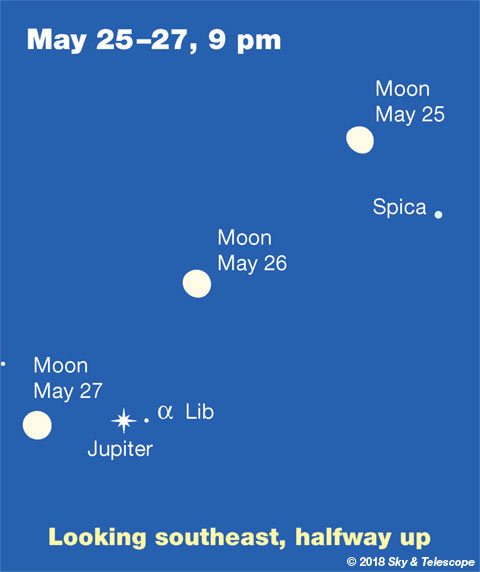
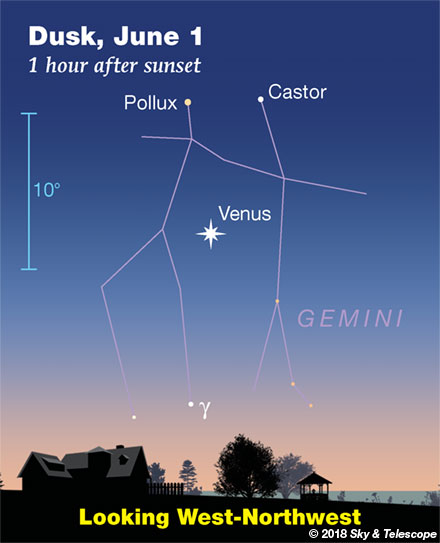
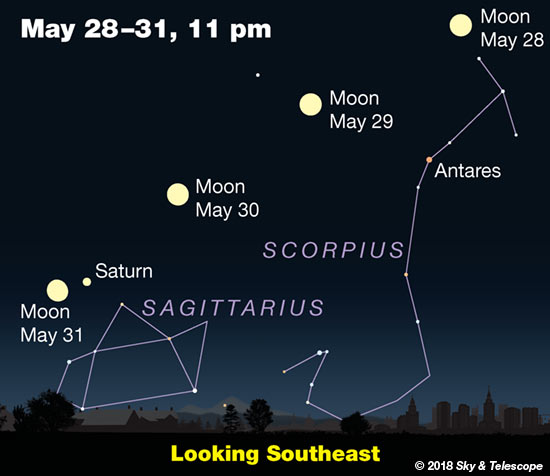
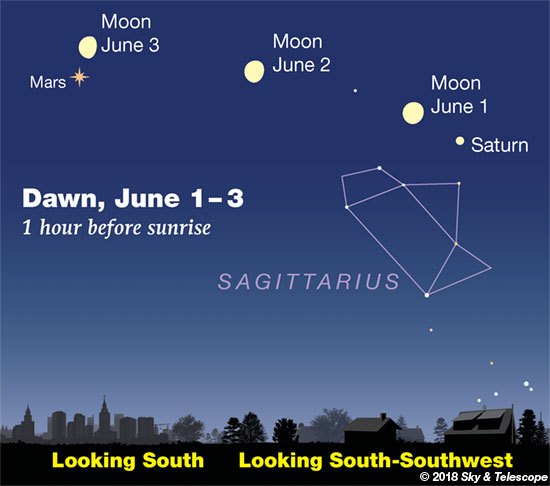
Friday, May 25
• As the waxing gibbous Moon crosses the sky tonight, Spica hangs below it, as shown in early twilight here.
• The Arch of Spring spans the western sky in late twilight, arching over Venus. Pollux and Castor form the Arch's top; they're lined up over Venus roughly horizontally. Look well to Venus's left to find Procyon, the left end of the Arch. Look farther to Venus's right for Capella, the Arch's right end.
Saturday, May 26
• Tonight the Moon forms a flat triangle with Spica and brighter Jupiter, which are more or less on opposite sides of it, as shown here. This is their arrangement in bright twilight. The whole scene rotates clockwise as it moves westward through the night.
Sunday, May 27
• Now Jupiter shines to the Moon's right in the evening. They may look like companions, but Jupiter is 1,700 times farther away.
And very high above them shines bright Arcturus, 530,000 times more distant than Jupiter.
Monday, May 28
• Jupiter's moon Europa emerges out of eclipse from Jupiter's shadow around 11:13 p.m. Eastern Daylight Time. A small telescope will show Europa gradually swelling into view just off the planet's eastern limb.
Tuesday, May 29
• For the next 12 days, Jupiter stays 1° or less from 3rd-magnitude Alpha Librae (Zubenelgenubi): a fine, wide double star for binoculars. Its two components, magnitudes 2.8 and 5.1, are a generous 231 arcseconds apart. Nevertheless they form a real, gravitationally bound pair; they're both measured to be 77 light-years away. They're bigger and brighter than our Sun, shining with 36 and 4 times the Sun's light.
• Shining in the east-northeast after dark is Vega, the brightest and currently highest star of the Summer Triangle. But with summer still three weeks away, the Triangle's final star doesn't rise above the eastern horizon until about 10 p.m. That's Altair, the Triangle's lower right corner. The third star is Deneb, sparkling less far to Vega's lower left.
Wednesday, May 30
• Vega is the brightest star in the east-northeast after dark. The other main stars of its constellation, Lyra, currently dangle down from it.
Thursday, May 31
• The waning gibbous Moon rises around the end of twilight. Once it's up you'll find Saturn glowing to its right (for North America). Are they companions? Nope, Saturn is 3,400 times farther away!
Friday, June 1
• Constellations seem to twist around fast when they pass your zenith — if you're comparing them to the direction "down." Just a week and a half ago, the Big Dipper was floating horizontally in late twilight an hour after sunset (as seen from 40° N latitude). Now it's angled diagonally at that time. Another week and a half and it will be hanging straight down by its handle!
Saturday, June 2
• "Cassiopeia" usually means "Cold!" Late fall and winter are when this landmark constellation stands high overhead (seen from mid-northern latitudes). But even on hot June evenings, it still lurks low. As twilight ends, look for it down near the north horizon: a wide, upright W. The farther north you are the higher it'll appear, but even as far south as San Diego and Atlanta it's completely above the horizon.
________________________
Want to become a better astronomer? Learn your way around the constellations! They're the key to locating everything fainter and deeper to hunt with binoculars or a telescope.
This is an outdoor nature hobby. For an easy-to-use constellation guide covering the whole evening sky, use the big monthly map in the center of each issue of Sky & Telescope, the essential guide to astronomy.

Once you get a telescope, to put it to good use you'll need a detailed, large-scale sky atlas (set of charts). The basic standard is the Pocket Sky Atlas (in either the original or Jumbo Edition), which shows stars to magnitude 7.6.
Next up is the larger and deeper Sky Atlas 2000.0, plotting stars to magnitude 8.5; nearly three times as many. The next up, once you know your way around, is the even larger Uranometria 2000.0 (stars to magnitude 9.75). And read how to use sky charts with a telescope.
You'll also want a good deep-sky guidebook, such as Sue French's Deep-Sky Wonders collection (which includes its own charts), Sky Atlas 2000.0 Companion by Strong and Sinnott, or the bigger Night Sky Observer's Guide by Kepple and Sanner.
Can a computerized telescope replace charts? Not for beginners, I don't think, and not on mounts and tripods that are less than top-quality mechanically (meaning heavy and expensive). And as Terence Dickinson and Alan Dyer say in their Backyard Astronomer's Guide, "A full appreciation of the universe cannot come without developing the skills to find things in the sky and understanding how the sky works. This knowledge comes only by spending time under the stars with star maps in hand."
This Week's Planet Roundup
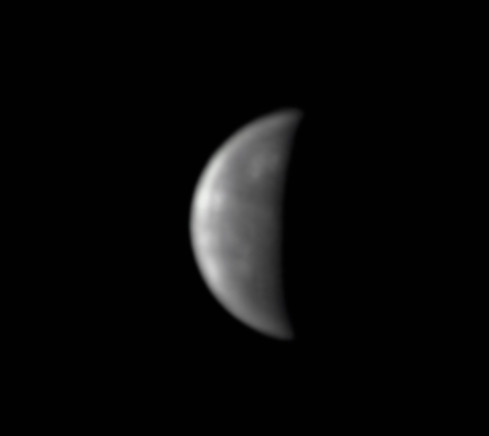

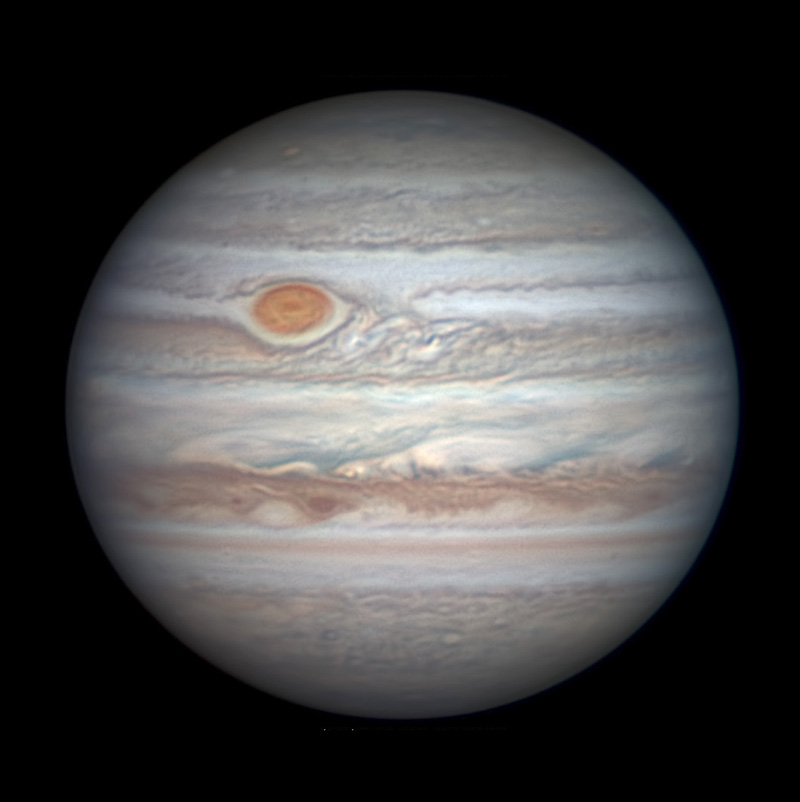
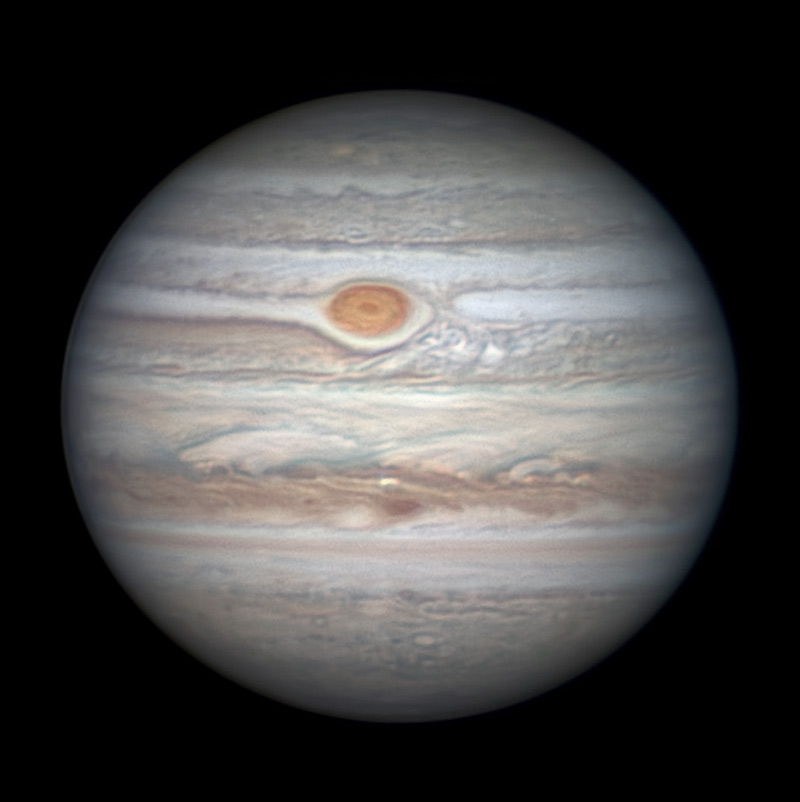
Mercury is lost in the glow of sunrise.
Venus (magnitude –3.9, in Gemini) shines brightly in the west-northwest during evening twilight and just after. This is about as high in twilight as Venus is going to get. In a telescope (look early, as soon after sunset as you can pick it up) Venus is a gibbous disk 13 arcseconds wide and 81% sunlit.
Mars (magnitude –1.2, in Capricornus) rises around midnight daylight-saving time. Watch for it about 26° lower left of Saturn. By early dawn Mars glares orange in the south. It's brightening rapidly now, on its way to an unusually close opposition in late July. Already Mars is 14 or 15 arcseconds wide — slightly bigger than at its poorest oppositions!
What detail can you see on Mars in your scope? You'll want a Mars map that identifies which features are facing Earth at your time and date, such as our Mars Profiler.
Vesta, the brightest asteroid, is having an unusually close and bright apparition in the Ophiuchus Milky Way a little north of Saturn. It's currently magnitude 5.7 and will brighten to 5.3 around its June 19th opposition. Article and finder charts: Vesta Gets Close and Bright, by Bob King.
Jupiter (magnitude –2.5, in Libra) shines well up in the south-southeast as twilight fades. It's highest in the south, presenting the sharpest views in a telescope, by 11 or midnight daylight-saving time. It's still a generous 44 arcseconds in equatorial diameter. See our telescopic guide to observing Jupiter in the May Sky & Telescope, page 48.
Saturn (magnitude +0.3, just above the Sagittarius Teapot) rises in the southeast soon after the end of twilight. It stands highest in the south around 3 a.m., about 26° to the right of brighter Mars.
Uranus is hidden in the glow of dawn.
Neptune (magnitude 7.9, in Aquarius) is low in the east-southeast before the beginning of dawn.
______________________
All descriptions that relate to your horizon — including the words up, down, right, and left — are written for the world's mid-northern latitudes. Descriptions that also depend on longitude (mainly Moon positions) are for North America.
Eastern Daylight Time (EDT) is Universal Time (also called UT, UTC, GMT, or Z time) minus 4 hours.
______________________
"Remember to look up at the stars and not down at your feet. Try to make sense of what you see and wonder about what makes the universe exist. Be curious."
— Stephen Hawking, 1942–2018
______________________
"The dangers of not thinking clearly are much greater now than ever before. It's not that there's something new in our way of thinking, it's that credulous and confused thinking can be much more lethal in ways it was never before."
— Carl Sagan, 1996
______________________
"Objective reality exists. Facts are often determinable. Vaccines save lives. Carbon dioxide warms the globe. Bacteria evolve to thwart antibiotics, because evolution. Science and reason are not a liberal conspiracy. They are how we determine facts. Our survival depends on our ability, and willingness, to do so."
— Alan MacRobert, your Sky at a Glance editor
______________________
"Facts are stubborn things."
— John Adams, 1770
 3
3








Comments
misha17
May 25, 2018 at 4:58 pm
According to Greek mythology, after Orion's fatal encounter with The Scorpion, the gods placed them in opposite sides of the sky so they wouldn't bother each other anymore. In reality, it's the Bull and the Scorpion that are opposite each other - Antares (Right Ascension 16h 29m) is opposite the Sun on May 30 or 31st, within a day or so of Aldebaran's (Right Ascension 04h 35m) conjunction with the sun.
You must be logged in to post a comment.
Rod
May 30, 2018 at 12:01 am
"Tuesday, May 29 • For the next 12 days, Jupiter stays 1° or less from 3rd-magnitude Alpha Librae (Zubenelgenubi): a fine, wide double star for binoculars..." I hope someone gets a good photo. I was viewing tonight at 25x and 31x (1.8 and 1.6 degree true field) using Televue 40-mm plossl and TeleVue 32-mm plossl. Jupiter (belt bands visible), the 4 Galilean moons, Alpha Librae double star and some other stars all in the same telescope field of view. Lovely sight! Full Moon lower in SE behind some cirrus clouds. Below Jupiter were some other cirrus clouds lit up by the Full Moon light. Everything begged for some good photos here 🙂 I viewed from the Patuxent River Park area in MD.
You must be logged in to post a comment.
mary beth
May 30, 2018 at 2:28 pm
I did a Google search for you and this was all I could find so far:http://spaceweathergallery.com/indiv_upload.php?upload_id=144850. Maybe the Astro Bob website will post pictures at some point. You're right it is a beautiful sight! I so enjoyed the southeast sky last night, with Antares joining the scene!
You must be logged in to post a comment.
You must be logged in to post a comment.